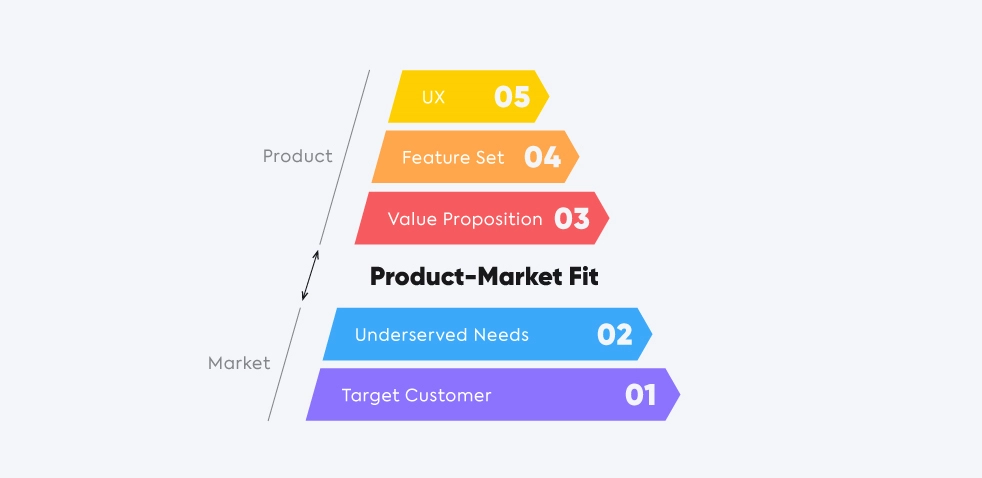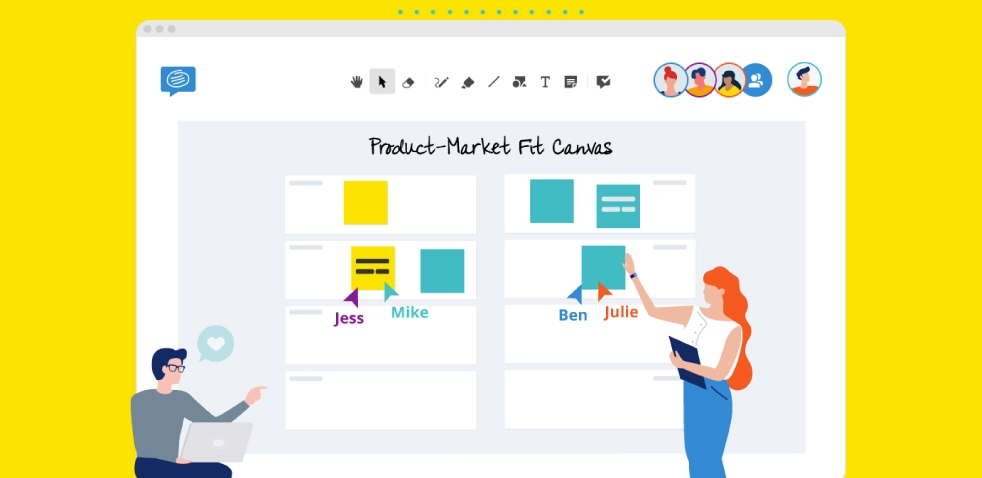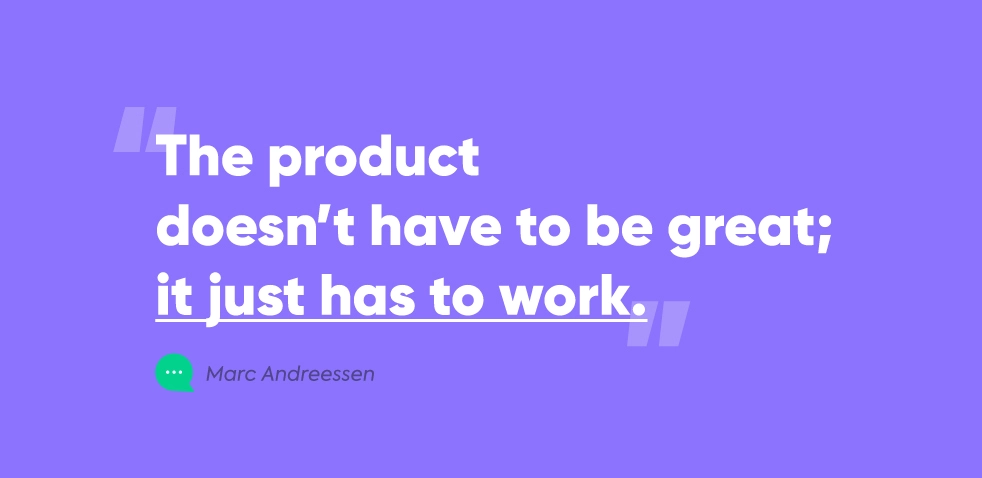
Startup
Startup

We can all agree that to create a successful startup, you need to find the right product-market fit.
In a nutshell, we can define product-market fit as the answer to the needs and wants of the current market. However, many find themselves stumped with the concept itself, or how to find the right product-market fit and capitalize on it.
If you’re unsure of what the product-market fit is, how to find, measure, and analyze it — you’re in the right place. In this guide, we’ll go over every aspect of product-market fit to help you find the best SaaS solution.
Product-market fit is a term commonly used in a SaaS environment and is also referred to as P/M fit or PMF.
Marc Andreessen, an entrepreneur and investor first coined the term product-market fit in THE PMARCA GUIDE TO STARTUPS, under the chapter “The only thing that matters.” Here, he defined PMF as “being in a good market, with a product that can satisfy that market.”
Since then, our understanding of product-market fit has somewhat changed, but it’s core values and importance have still remained consistent. After all, a good idea can only get you so far. It’s knowing how, when, and where to apply it that gets your startup a step closer to success by allowing you to scale up and reach more customers.
All of that being said, there are several ways of going about finding the product-market fit. First, we’ll talk about the Pyramid model, before going into our in-depth guide on finding PMF.
Many people find it easier to understand the product-market fit through an actual, observable model, which can be applied to various startups. This is where Dan Olsen’s Market Fit Pyramid and product-market fit startup analysis can come in quite handy.

You’ve likely already seen this picture, as it’s quite often the poster child of product-market fit, as it helps explain it easily. The idea behind it is that everything starts with the target customer (the base), and their underserved needs as the bottom two layers.
Then, the top three layers start with the value proposition, a concept that pertains to the way you plan on creating a unique and superior product. The middle layer is the feature set, which refers to the exact solution you’ll present to your customer to help solve their problem.
At the very top of the pyramid, as the icing on the cake, is the UX (user experience), or the way you represent the product and functionality to your clients.
Per Dan Olsen’s pyramid model, the product-market is what lays between and connects the top and bottom layers. Moreover, he states that both your hypotheses and execution must be solid across all layers to execute the perfect product-market fit.
You can use this ideology to help document your research, ideas, and execution plans for the perfect market fit. If you’re interested in learning more about the product-market fit pyramid, you can check out Dan Olsen’s Lean Product Playbook. However, if you’re looking for more specific advice — keep reading.
Depending on who you’re talking to, finding the product-market fit could be the easiest or the most difficult thing you will ever do. Some lucky startups manage to find PMF on their first try, however, that’s not the case for most.
The vast majority of companies have to go through a long arduous process and experiment with various ideas before finding out whether or not they’ll succeed. Only then, they can start to leverage their idea to make way for a startup’s growth and ultimate success.
We know all of this may sound overly complex at first, but when broken down into a series of easy steps, you can make finding PMF easy and straightforward. So, we’ve gathered the advice of top product-market fit and SaaS professionals to help you out.
The product-market fit for your SaaS needs to be the answer to a question, and solve real problems — for actual clients. Think of the issues you know businesses face, which obstacles were in their way, and how can you get rid of them?
Ask your clients what their businesses need, or think back about what they’ve complained to you about. Don’t be afraid to bide your time while waiting for the perfect idea to come, as it will bring you more success in the long run.
Moreover, by doing your research thoroughly you’ll get a good idea of where to start, and then you can begin working on the solution for the problem. If you find it difficult to begin, we recommend using the product-market fit canvas model to help you find the perfect product-market fit.

Your future customers and the target market should be the primary focus of your SaaS solution. Many startups try to create a product-market fit that can reach multiple markets, and solve many different problems – but this isn’t realistic. The end result is a confusing solution, that serves no true purpose or answers the market needs.
So, listen out for the needs, trends, and pitfalls of the particular market, and keep track of them. Identify the solution that your focus market needs and your clients will likely offer to pay for it — thus, increasing your odds of finding the perfect product-market fit.
Building a startup, and finding the right product-market fit takes some creativity. But as with all else, cooler heads ought to prevail in the end. Meaning, even if you think you’ve found the most obscure, perfect niche idea that nobody has ever thought of — it may not allow for the best product-market fit. On the contrary, the best solution to a problem needs to be rooted in reality and based on the needs of the market before all else.
As Marc Andreessen puts it, “the product doesn’t have to be great; it just has to work.” So, find an idea that will provide a solution that your clients are facing, and they’ll more than likely be willing to invest in it.

Good marketing and branding can make or break any product. So, once you’ve found a product-market fit for your SaaS, you should look for the best branding companies for startups. There are even companies that specialize in creating complete branding and marketing strategies for startups and will help you create an identity that fits your product perfectly.
Additionally, there are plenty of free online resources that allow you to brand and market the product by yourself. If you’re interested in learning more about startup branding, consider reading the book Startup branding funnel: a new approach for developing startup brands.
Related: Branding your Startup 101: The Ultimate Guide
Competition is a fact of life in every business, and it shouldn’t scare you off your idea. After all, just because there’s one solution available, doesn’t mean that isn’t room for a new and improved version.
Let’s take, as an example, startup clothing or fashion brands. These companies face an overwhelmingly competitive market, within which they have to find a niche. Not only that, they have to be extremely careful when it comes to crafting their image, as this is the nature of the field they’re entering.
However, if they manage to find the right product-market fit and launch it at the right time — they become an instant success.
This example should illustrate that you don’t need to fear your competition, but figure out how to outsmart them instead. Also, rely on your startup branding strategy to set you apart from the competition, while giving your product room to speak for itself.
You will probably have a million ideas for different SaaS features, especially if you come from an engineering or software background. However, your clients will appreciate the functionality and accessibility above else.
They might even feel overwhelmed and annoyed at the solution is too difficult for them to learn and get accustomed to. Moreover, your customers will likely feel quite frustrated if they need to learn various features — only to never use them again.
So, remember that the clients are looking for solutions to help them do business more conveniently and efficiently — and keep that in mind when adding new functionalities.
If you still feel like you need some additional help in finding the PMF, we recommend taking a look at The Product-Market fit Steve Blank.

The product-marketing fit must be thoroughly tested out, and verified before you can release it to a wider audience. You can do so by asking your clients to answer a product-market fit survey, and keeping in touch with them, to check if there’s anything they’d like to change.
This way, you’ll be able to make sure the PMF is serving it’s perfect and make some changes if needed before approaching new potential customers. Not to mention, you’ll need to prove the product-market fit before approaching potential investors.
Keep in mind that this process can’t be rushed, as that will hinder product development and your future success.
Once you think you’ve found your perfect PMF, you’ll need to measure it to check if it actually fits. There are several ways of going about this, and we recommend combining all of the methods to be able to measure the PMF as best you can.
Surveying your current users in a thorough and meaningful way is one of the best ways of measuring the product-market fit. However, you have to make sure you ask questions in a way that takes any guesswork out of the equation.
Be straight-forward with your questions, and ask your clients how they would feel if the product became unavailable. To make it easier for them to answer, and for you to manage the information, offer multiple selection questions. The answers could range from “not disappointed” to “extremely disappointed”, and a few in between.
At the very least, you should have 40% of users say that they would be extremely disappointed if they couldn’t use the product. Finally, make sure you’ve gathered a big enough sample so that the data is relevant and you know where your PMF stands.
If you need any additional help with measuring the product-market fit, we recommend taking a look at How to Establish Product-Market Fit: SaaS Growth Metrics to Focus On.
Net Promoter Score (NPS) helps you see how likely your clients are to refer you to someone else. While these services also revolve around surveying users, they allow you to reach both happy clients and those who are neutral or dissatisfied with your services.
Thus, you’ll be able to get a better insight into how actual or would-be clients feel about your product to check whether you’ve found the PMF.
Another good way to gauge the product-market fit is to see whether your users are sticking with you and your product. Keep track of whether your users are reaching out to you in a positive way, complementing the product, or are they drifting away and completely abandoning the product?
This will make it abundantly clear whether you’re offering a unique, remarkable solution, or one that can be easily replaced and forgotten.

Many SaaS entrepreneurs emphasize that it’s quite important to trust your intuition when first launching the product. However, this means that you have to be realistic with yourself, the product, and the startup.
If you aren’t getting any great press or reviews, referral clients and the sales cycles take way too long — the PMF isn’t happening. That means it’s time to move on to finding a better fitting product.
However, if your phones are going off the hook, you can’t keep up with the influx of emails, and are seeing a lot of referrals, you’re surely on to something. You need to make the most of PMF as it happens and double down on the effort to keep your customers happy with the SaaS.
Is Product-Market Fit Real?
Yes, the product-market fit is a real, and significant aspect of creating your SaaS. Just as with everything else in life, if the product doesn’t fit, it will become obsolete. So why bother with a SaaS in the first place if it’s not going to fulfill a need on the market by birthing a meaningful product?
Why Is Product-Market Fit Important?
You can’t expect your SaaS or startup to prosper without the right product-market fit. It’s what makes or breaks businesses, so it’s an important aspect to keep in mind and track during the development of your SaaS.
How to Find Product-Market Fit?
You can find product-market fit through researching a market, thinking outside the box, and trying to find solutions to real problems. After that, you can start working out the logistics of the solutions and presenting them to your clients.

Startup

Startup
You just submitted a request successfully. We will get back to you soon.